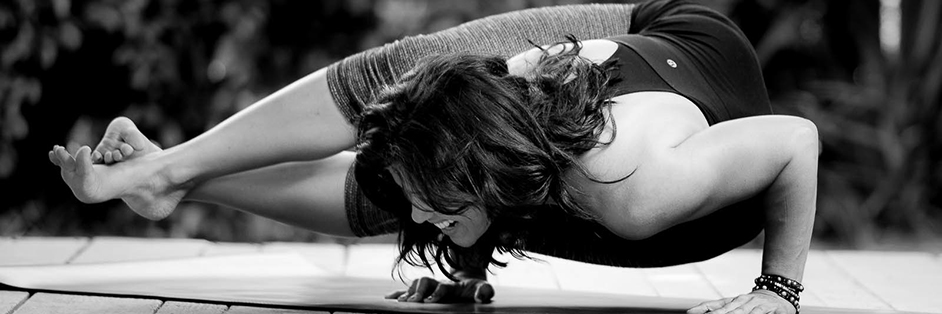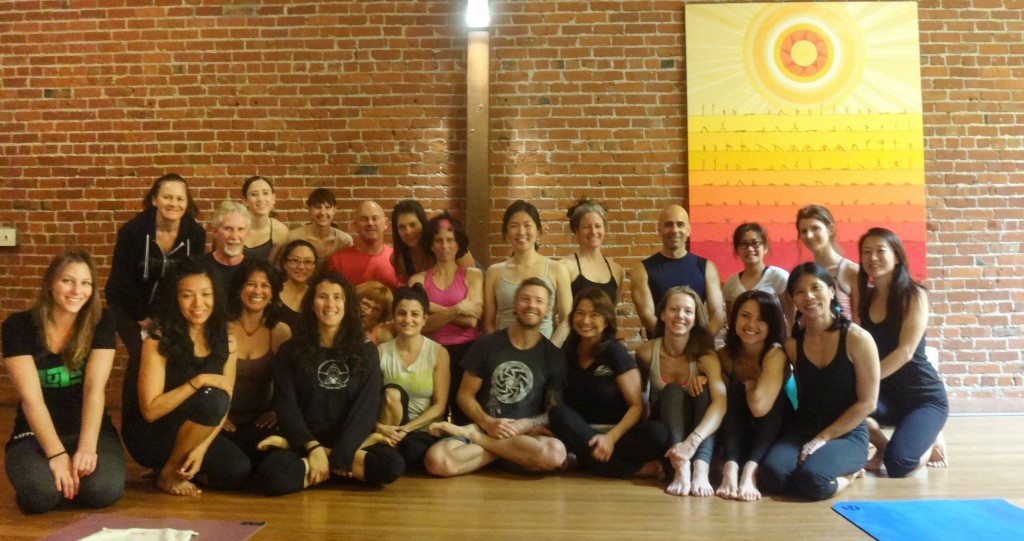Notes on Led Primary
Today my teacher, Erika invited us to approach our practice in a different way. Having recently have listened to Stu Girling’s interview with Tim Feldman “From Dance to Yoga”, my teacher brought the information/perspective first to her own mat, then shared a few of the lessons learned within her instruction of today’s led practice.
The primary concept she shared with us was a way to approach our current “challenge pose” throughout the entire practice. With the notion that the sequence builds upon itself, we were asked to see our “challenge pose” in each of the asanas leading up to it. As she led us in the series, she called our attention to the little connections linking the pose we were actively inhabiting to another pose or action such as binding, backbending, or hip opening. Of course she constantly reminded us of our bandhas: mula bandhas in particular. Today’s cues resonated with me in a little differently than they have in the past. I feel like I was able to inhabit the poses in a new way. I wish I had been afforded the time to jot down a few notes after class for the magical cues escape me now. With any luck, they will return the next time I step foot on the mat.
Note: Stu’s Dialogue with Tim Feldman is available on YouTube and full of a wealth of information. I’m nearly half way through listening to it. And although I’ve yet to hear things phrased in the same way as Erika put it, I am gaining a lot of insightful tidbits. Check it out.
bad ashtangi; good ashtangi
I lay in my bed, curled up under a protective blanket which shields me from the bitter cold world around me. Just a few feet away lies my yoga mat. It does not call to me; it lays there quietly leaving it completely up to me to decide whether to hide beneath my blankets or face the cold reality of my own little world.
My body is sore, as always, but my will completely exhausted. I’ve been feeling this fatigue through the majority of last week and have been attributing it to the added stress of caring for my son who has been sick with a resistant infection. More likely than not, the fatigue is in part due to my routine being broken: a week of practice at varying hours of the day to make room for the added tasks of a mommy how has seen too much of the inside of the ICU. With only a couple days of mysore last week, my practice routine is quite vulnerable.
I feel myself getting pulled back into the warmth of my bed, while a teeny tiny part of me tries to shame me to my mat. “You are a BAD Ashtangi,” it says as I pull my covers over my head to shield from the light coming through the window. If I don’t see that the mornings aren’t as filled with darkness as they once were, I can still use that as my excuse. Quite frankly, my bed isn’t all that comfortable in the morning. I have my arthritis and a weekend of tough hiking to thank for that. However, just like that, I give into the criticism that “I AM a bad Ashtangi” and roll into the fetal position.
By the time I realize that I am buying into the lie once again, too much time has passed for any real sort of practice. It is sad because the truth is, I want to be a good Ashtangi. No, I *need* to be a good Ashtangi; This practice has been doing wonders for my health. Some of the greatest lessons I’ve learned in the past many months have occured on my mat. Today, I get to learn how much I need my practice by missing out on its benefits. And, because of this, the world continues to be seen as cold, my body sore, and my will beaten into submission.
Tomorrow, will be different. Tomorrow, I WILL be stronger. I will see the story as fiction and emerge of my own will. Tomorrow, I will acknowledge that the cold isn’t all that cold and will allow myself to notice the sun shining through my windows and let it bring light to my already-beautiful world.
No love lost
I remember being a new yogini and watching my instructor easily demonstrate a pose we were all to try. At that moment, I was completely in awe of her – never imagining that pose would be even remotely possible for me to achieve (in ANY form). Sometime later, I squealed in class when I found myself able to lift both feet off of the ground, if for only a second or two, and teeter on my arms. Titibasana! Well, sort of.
You’d think I had been given the secrets to flying by the amount of enthusiasm this moment produced. I went home and immediately tried again…over and over and over again. If there was any place where this pose could potentially be done, I was all over it. It might not have been pretty but it was fun.
My yoga practice grew and I learned other arm balances. One by one, I became obsessed with each of them – which wasn’t always a good thing. I even broke a toe trying to learn one of them. Of course, that didn’t stop me.
Then came Ashtanga…and learning how to access stability through a more grounded practice instead of the flighty, playfulness of my past. I learned to be focused within and more conscious of alignment. My practice and body have changed. Titibasana, which is more of a Vinyasa (or transition), comes late in my practice — after fatigue has set in and I have just been curled up in a little ball. More often than not, I hardly recognize it as that pose I once loved to do on every rock, downed tree, or dilapidated old cow shoot I came upon. I wondered if I could even do Titibasana anymore.
Today, I decided to spend a little more time with Titi. After my practice, I remained on my mat to get reacquainted. I explored the pose from a different approach: one focused on alignment, stability, and a changed body.
Life on the Mat after a weekend Ashtanga Yoga Intensive
This past weekend, I attended an amazing Ashtanga Yoga Intensive with master Ashtanga teacher and practitioner, David Robson. Teaching from a traditional approach to the method, we were given a slew of information on all sorts including (but not limited to) the Vinyasa count, marrying the movement to the breath for a floaty practice, and jumping back and jumping forward.
I had so much to think about when I rolled out my mat in Mysore today. The various teachings all swirling in my head: alignment, timing the movement with the breath (and not the reverse), maintaining the bandhas throughout, not letting the distractions take your mind on a detour, etc. All good, to a point, but I noticed this swirling of lessons becoming just another form of vritti distracting me from the work.
It started out quietly but began building as I progressed through the series. Before long the chatter of what I am not doing became so much that I started murmuring under my breath. I caught myself, and hoped the guy beside me was too focused to have noticed too. Then I directed my mind back to the breath. It was a bit much. Yet, I tried not to judge and didn’t let myself give into it. I noticed it, even noticed myself noticing, then returned to the breath.
Inhale, Exhale, Inhale, Exhale…
My breaths today were quick in places (as is often the case) but I adopted David’s advice to stick with the traditional count — rather than my previous approach of doubling the breath count to make up for my shorter breaths. I noticed an attachment to the poses, as I forced myself to move to the next in the sequence before my back had gotten a chance to release.
It’s a new approach but I think there’s a good lesson for me here. Of course it helps to keep track of the count; there were a few times in the seated poses where I noticed I was on six and had yet to lift my head.
As for lifting up and floating back… Read More
Today’s Lunch: Seated Postures
This morning, I came to my mat in a lot of discomfort. Possibly from yesterday’s full primary on Dave Robson’s much longer breath count, but more likely from too many weeks between chiropractic adjustments. To be honest, this soreness has been building for a couple of weeks now and, although I have been hitting my mat daily, I could feel more than one area of my spine which didn’t quite seem to move as easily as it used to. After about 35 minutes of the sequence, which equated to the Suryas and the standing poses, I abandoned all efforts and sat down on my mat to meditate.
I resisted the urge to beat myself up for giving up on it so early on. I just let it be and got up for my morning espresso.
A couple hours later, I found myself longing for just a little more. Without a change of clothes, I found myself headed towards the yoga studio with plans to pop into mysore in my jeans for a do-over. If I only did the Suryas again, I would have been happy but… as I got closer to the studio I remembered that Friday’s practice was lead Full Primary and I was too late to join. *sigh*
My chiropractor managed to find all my stiff areas and got them all moving again by the time I hopped off his table. My low back was still feeling stiff as I drove off to work – but the rest of me felt better. I immediately began devising a plan to roll out my mat during my lunch break. The package of tuna in my file cabinet would have to suffice for nourishment as it was movement or eating (one or the other).
I found an empty conference room at lunchtime and began going through the motions at the top of the hour. I immediately noticed the difference in the range of motion in my upper back. I went through Surya A & B then moved straight to the seated postures as I’d done the standing series already today. I celebrated successfully getting my ankle to tolerate Marichyasana B and C on my left side – the first time in ages. I finished up with Navasana and stopped there as my break was over.
It was all good. Feeling relief, I returned to my desk. And it didn’t matter that my tuna package was only a measly 80 calories worth of nourishment. I was sure I could find something else to satisfy my need for food if I needed to. For it seemed that today, it wasn’t food as much a movement that my body was hungering for.









